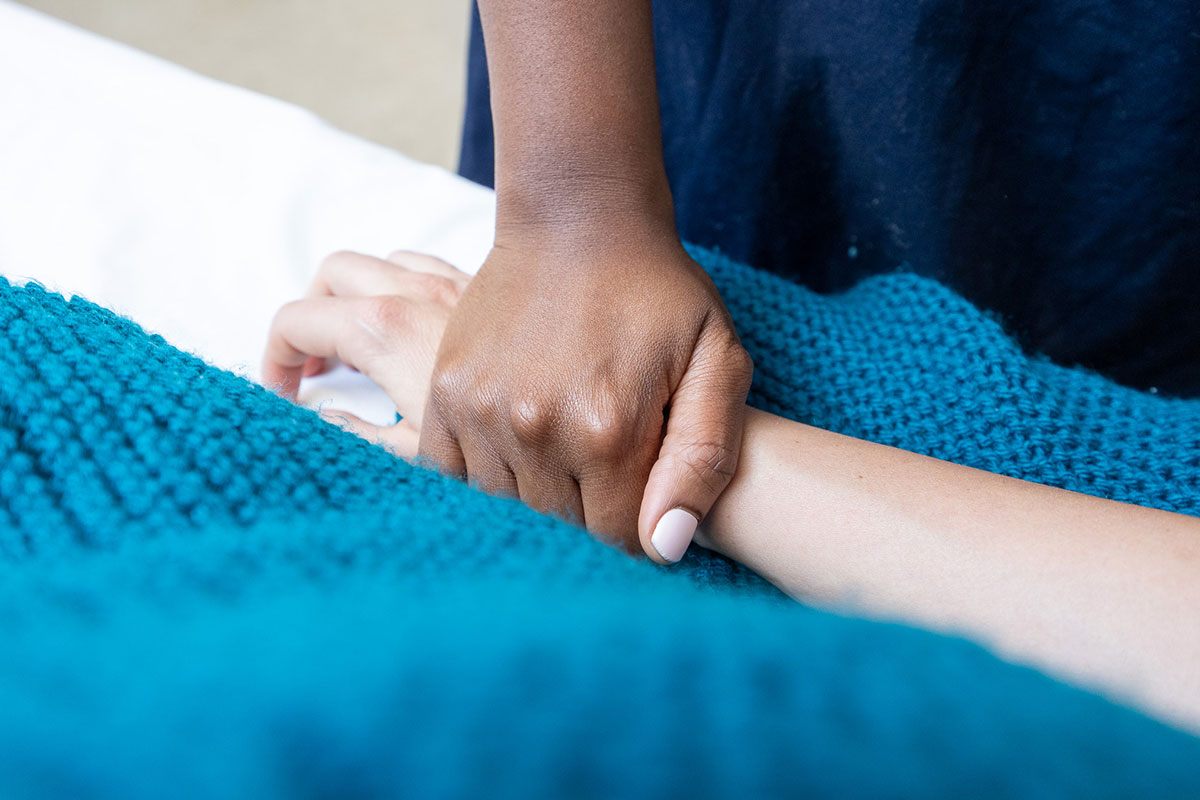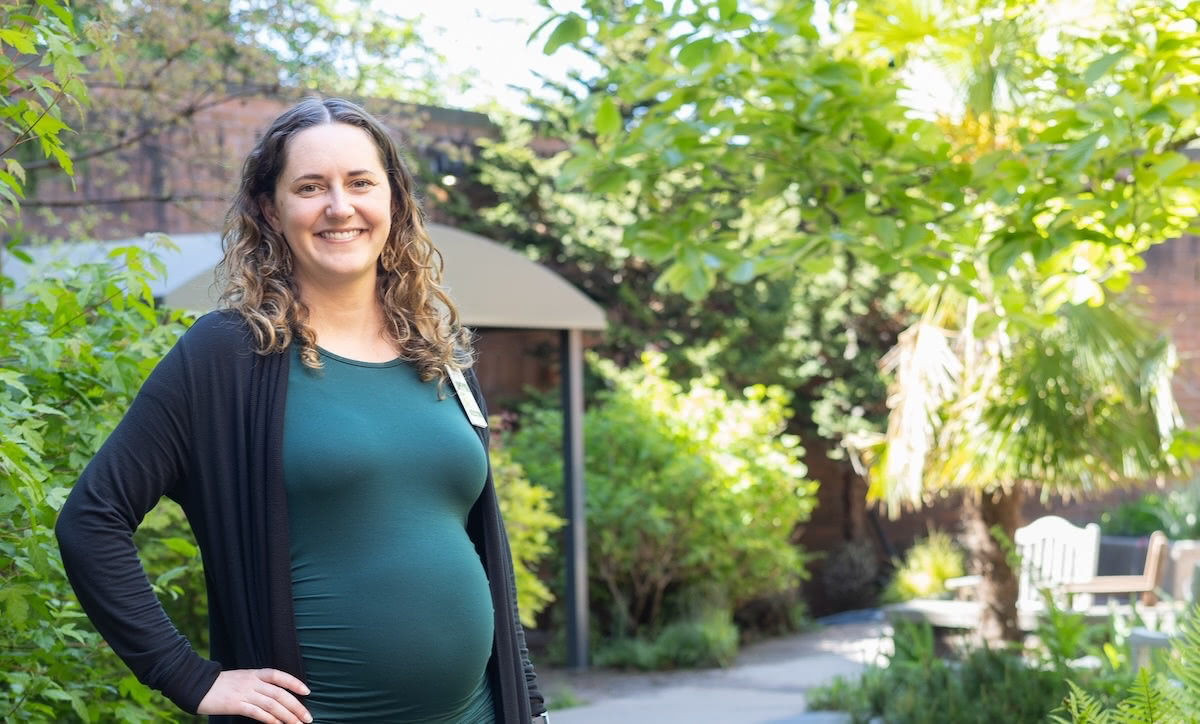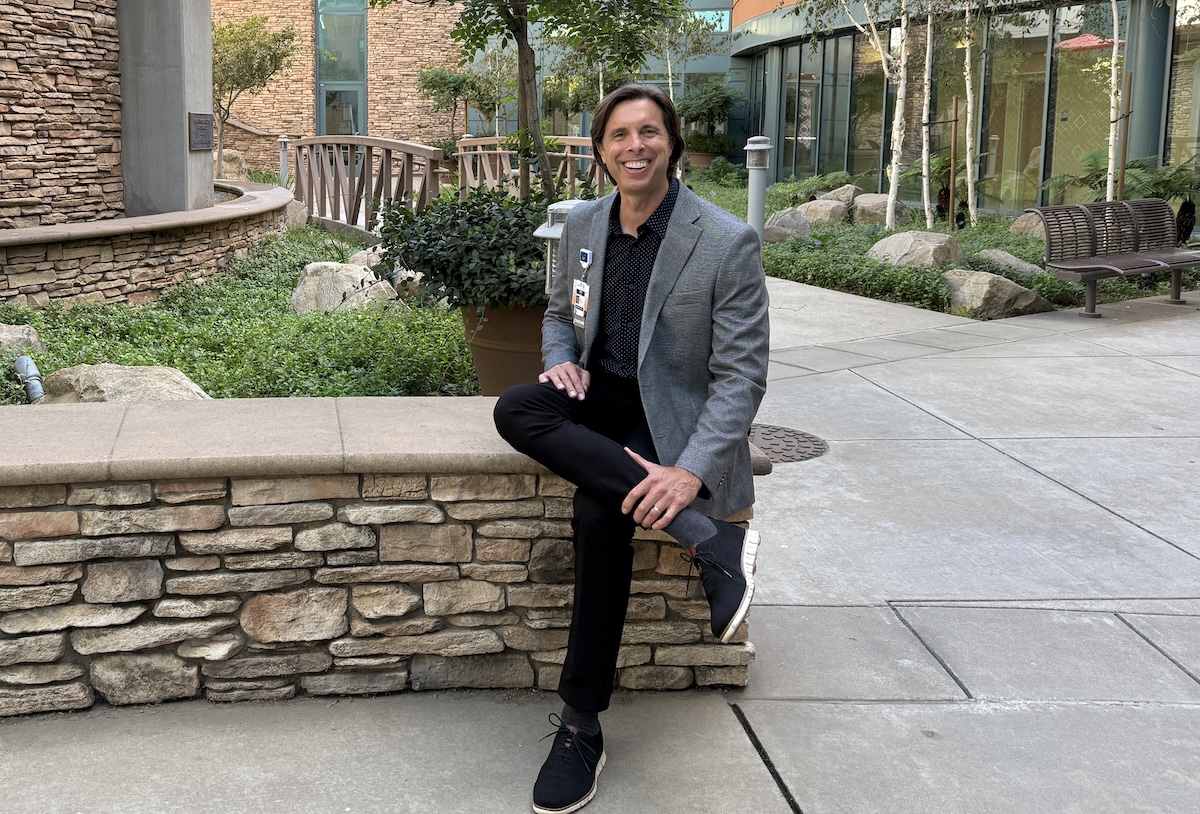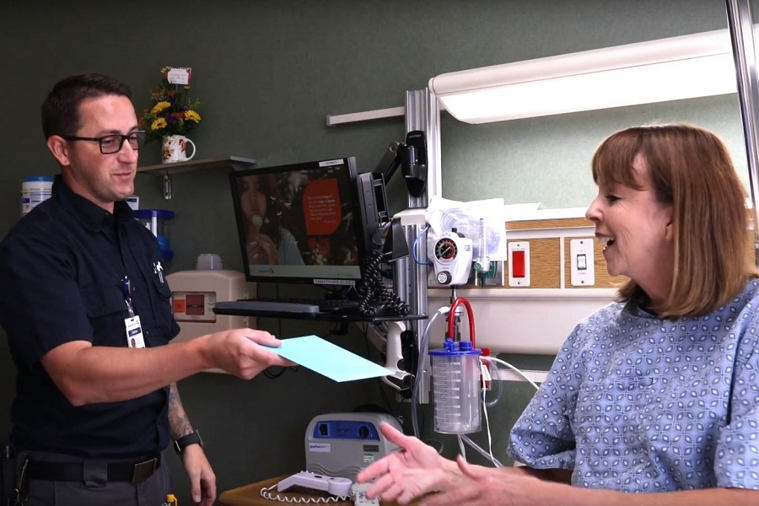Team Spotlight
Wrapped in Love: Handmade Blankets Comfort Hospital Patients
Aug 18, 2025

When a patient from Vancouver, Washington, wanted to give something back to Adventist Health Portland she started a knitting club.
The neatly folded stack of handcrafted lap blankets sitting on Chaplain Tino Tsikirai’s desk may look out of place for a hospital office setting. Variegated yarns and assorted textures catch the eye of office visitors but only hint at the intriguing story of where the blankets came from, why they’re here, and where they’re going.

The story begins in the busy, skillful hands of knitters and crocheters at the East Woods Presbyterian Church in Vancouver and unfolds gently in rooms across the hospital where family members have gathered around loved ones with hope and sometimes grief.
Each blanket is as unique as the patients who will receive them. The lap blankets are known as “comfort shawls,” “love blankets,” or “prayer shawls” depending on the patient situation. They are lovingly crafted by Linda, Marilyn, Carol, Alta, Sue, Shirley, Conni, Betsy, Vicky, Yvette, Marcy, and others at the church. The former patient knitter who started the group shall remain anonymous.
The blankets arrive at the hospital’s Mission and Spiritual Care office — Chaplain Tino’s home base — with gift bags and cards bearing words of encouragement for the patient and their family members. One line of the message says: “May the one who receives this blanket be cradled in hope, kept in joy, graced with peace, and wrapped in love.”
Chaplain Tino recalls visiting with a patient not long ago who was dying. “We talked, and we processed what she was going through,” says Tino. “Then I remembered the love blankets. I went to my office, chose a blanket with a very specific shade of deep teal, and took it to the patient’s room. Her eyes filled with tears when she saw it.
“‘That is the exact color on my couch at home,’ the patient said. ‘My whole house is made up of this color.’ It was such a comforting moment for her to have a little bit of home. It was beautiful to see her not just take in my words of comfort and hope, but also to have a tangible representation of comfort and warmth and safety — even in that moment.”
Yarn fused with love
There should be a word for the comfort of a blanket placed gently on you by loving hands, its weight a final nudge into deep sleep as you nod off on a chilly day. Perhaps this is “hygge” — the Danish concept of contentment and well-being. In the creation of these lap blankets, part of that sense of well-being comes from the compassionate care of the chaplains and other caregivers and part from an alchemy of love fused with yarn woven as church ladies chat and pray for patients who will receive their knitted gifts.
“The ladies at the church make them as quickly as possible because as soon as we get a set, we use them up,” says Tino. “Some days in the office, there will be just a few. On the days when we get a new batch, the office will be full of them. These blankets go quickly. Sometimes nurses from the floors actually will call the chaplains asking us to deliver them to the different units or specific patients. That’s how much these blankets have become a part of the caring culture here.”

Patients get to take the blankets with them when they leave the hospital. Some go home, others to a care facility or hospice. “It’s a tangible reminder that they are cared for, that they are seen for being human, and that they are loved,” says Tino. “In a hospital where there is a lot of white and blue, patients often don’t get to see a lot of bright colors, so it’s also a touch of life and hope.”
When a patient passes away, their family gets to keep the blanket. “It gives them something to hold onto besides the memories of the hospital,” says Tino.
Chaplains walk a careful line when visiting patients. It isn’t a time for proselytizing or a prophecy seminar. It’s time to show up as the hands and feet of Jesus, time for comfort, compassion, and grace.
“When we walk into rooms, we don’t assume a person is religious,” says Tino. “Sometimes when people hear the word ‘chaplain,’ a lot of religious trauma is triggered and they’re afraid to see someone who represents religion. So, when I walk into a room, it isn’t about having an agenda. It’s about seeing the person for who they are and helping them journey through whatever they’re going through.”
Where is God when things go wrong?
In June, Tino was with a family going through a very complex grief process.
“I provided chaplain support as they were experiencing loss — holding space for their tears, providing emotional and spiritual support, being present — but there seemed to be something more that was needed,” says Tino.
“I went to the office looking for a blanket,” she says. “There was a very specific colored blanket in a giant bag, a color connected with what the family was going through. I picked up the bag and I thought, ‘OK, this is the bag that I’m taking to this family.’
“I took it to the room and presented the blanket to the family that was standing around the hospital bed. Together we placed the blanket over the body of the patient. When it touched the patient’s body and family members placed their hands on it, their weeping resumed, but it was different this time. They were tears of — I don’t know how else to describe it — but more tears of comfort. There was a change in the tone of the tears.
“The crazy thing was the texture of that yarn was much softer than some of the textures we receive. In this delicate situation, the yarn was delicate and soft. In this delicate situation, the color was meaningful to what the family was going through. Everything, including the size of the blanket, was as if it was custom made for our patient who had passed.
“That day at the hospital had been a very full day. I’d worked with families going through diverse experiences, held space for different types of emotions, some happy, some painful. But the moment that made me cry at the end of the day was the moment with that blanket. Three months before that day was when the ladies would have started making this blanket. Three months ago, somebody unknowingly went to the store and bought yarn that was the color, the texture, the size that we needed for this family.
“It made me think of how God cared about the little details. He didn’t take away the pain the family was going through, but through that blanket, it was as if he was saying, ‘I’m still here. Even if the pain is still here, I’m still here.’
“It made me think of how many times in my life little things go wrong, big things go wrong, and I’m stressing. If God can care about the size, color, and texture of a blanket, what makes me think he doesn’t care about everything else in my life? It also taught me something about where God is even in the moments when things don’t fully make sense.”
Related articles

Team Spotlight
Meet Haley Pacholec, One of Our Teammates Shaping Mission-Based Healthcare at Adventist Health

Team Spotlight
Meet Chris Hagen, One of Our Teammates Shaping Mission-Based Healthcare at Adventist Health
